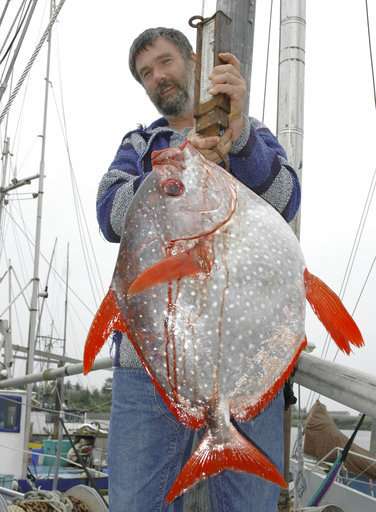Sleuthing leads to new findings about peculiar ocean fish

The fish buyer noticed something different about the large, colorful disc-shaped opah waiting to be sold at the auction house in Honolulu. Among the differences: one fish had a bigger eye than the other.
His curiosity set in motion DNA testing and more sleuthing that led to the identification of three new species of opah—a peculiar deep-diving fish recently found to be the first fully warm-blooded fish.
"The more we looked, the more differences we could pull out," said Karen Underkoffler, lead author of a recently published paper in the peer-reviewed journal Zootaxa that describes the anatomical characteristics of the different species of opah, including one marked by its big eyes and a purple tongue.
In all, the team of scientists with NOAA Fisheries identified five distinct species of opah, revealing that there isn't a single global species. Three are newly identified, one was already named and researchers better identified another that had been previously described.
"We have known for quite some time that opahs in different parts of the world look different," said Misty Paig-Tran, assistant professor of marine biology and biomechanics at Cal State Fullerton who was not involved in the paper.
People were calling them all the same thing, and the paper clearly shows their differences, she said, adding that it's great to finally have anatomical descriptions and DNA to back those descriptions.
The researchers say knowing the population of opah—which has a silvery gray body, red fins and mouths, and white spots—is important to make sure they don't get overfished.
While opah isn't harvested by commercial fisheries, the fish is often caught incidentally in commercial fishing for high-value tuna or swordfish off the coasts of Hawaii and California.
Sport anglers also frequently catch the colorful fish, which on average weighs about 100 pounds and can be bigger than an automobile tire.
Opah is becoming popular at restaurants in Hawaii and elsewhere. The value of U.S. commercial landings of opah has increased from just a few thousand dollars before 2000 to nearly $3.2 million in 2016. The Hawaii-based longline fishing industry reported the catching of nearly 30,000 opahs by vessels targeting tuna and swordfish in 2015.
Most opah landed by those vessels arrive at the United Fishing Agency auction in Honolulu, where Underkoffler was working several years ago when Garrett Kitazaki flagged the big-eyed opah for her and her colleague Megan Luers, another study co-author.
They took measurements, clipped fins and sent tissue samples to the Southwest Fisheries Science Center in San Diego. From the samples collected at the auction, the team quickly determined the fish were distinct from each other.
"In that effort to find more, we stumbled across more very distinct opah species," said John Hyde, program leader of genetics fisheries at the Southwest Fisheries Science Center who did the DNA tests.
They put out a call to museums, ports and commercial fisheries to get samples of opah. They thumbed through literature dating back to the 1700s to find references and descriptions of the fish. Underkoffler even traveled to Monaco to check out a specimen.
"It kept building and building," said Underkoffler, who now works for NOAA's seafood inspection program in Seattle.
Hyde said that "when you realize there are five species instead of one, it tells us there's a lot to still discover out there."
Journal information: Zootaxa
© 2018 The Associated Press. All rights reserved.




















